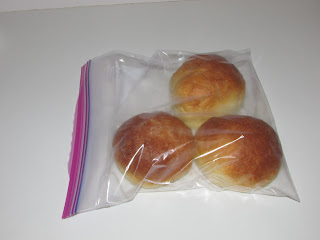Believe me, the comfort of the wood cookstove is not because we need the heat in the house. In fact, the windows have been open most of the time, and we have been letting the fire go out between meals if we have no need of hot water. What's comfortable is the pace and rhythm of the wood cookstove, the feeling that the stove and I are working in tandem (weird, I know), and the feeling that experimental cooking and long cooking times are neither expensive nor inefficient.
Furthermore, I said to Nancy the other night that having the cookstove going again just plain inspires me to want to cook.
And have I been cooking! I can't remember everything that was cooked this week, but one of the highlights was Beautiful Burger Buns for our barbecued beef sandwiches. This recipe is from the King Arthur Flour website, and it was a definite hit.
 |
| The three remaining hamburger buns. They are a little dry for sandwiches now, but they make excellent toast! |
Because I've been so inspired, I dug out my 1926 West Pottawattamie County Farm Bureau Women's Cookbook and began looking for more things to try from it. For Saturday's breakfast, I whipped up some cake doughnuts using a recipe out of this unique collection. They were good, but Nancy and I decided that we are not really cake doughnut lovers, so the chickens enjoyed the vast majority of them.
Tonight I used some leftover rice and made Raisin Rice Dainty, a recipe which was contributed to the cookbook by Mrs. Dudley Stupfell. I'm posting this recipe here to document how our taste in food has changed over the last ninety years. Initially, it caught my eye because I love rice and raisins together, and after reading the recipe, I was interested because it doesn't have much sugar in it and I'm trying to reduce my sugar intake a bit.
Then, when I read the directions, the idea of a cold rice dish reminded me of a very pleasant memory from my childhood. When I was about six or seven, my paternal grandparents went out to supper with us at a local restaurant called The Pink Poodle. I remember having a small dish of a pink desserty salad there that I thought was really good, so Granny and Dad also tried it in order to figure out what was in it. I remember how surprised we all were when Granny announced that one of the ingredients was rice. This recipe is a little like that.
Here is what you need:
2 cups cold cooked rice, packed loosely
(You cooked this rice on the wood cookstove, of course. You could also use prepared instant rice using this method.)
(You cooked this rice on the wood cookstove, of course. You could also use prepared instant rice using this method.)
1 cup raisins
1/3 cup powdered sugar
1 cup whipped cream (measured after it is whipped--approximately 1/2 cup before whipping)
1 tsp. vanilla
The directions are pretty simple:
1. Combine the rice, raisins, and powdered sugar.
2. Blend the vanilla into the whipped cream.
3. Fold the rice and raisin mixture into the whipped cream.
4. Put into small glasses and serve extremely cold.
I garnished this with a small dollop of unsweetened whipped cream on the top.
 |
| We only have one little footed sherbet glass like this. I would estimate that this is about a quarter of the total recipe yield. |
But maybe it's not worth updating. I don't know. Maybe this post's recipe is best left as a history lesson.
So what about the title? Have you heard of any other kind of "dainty"?
















